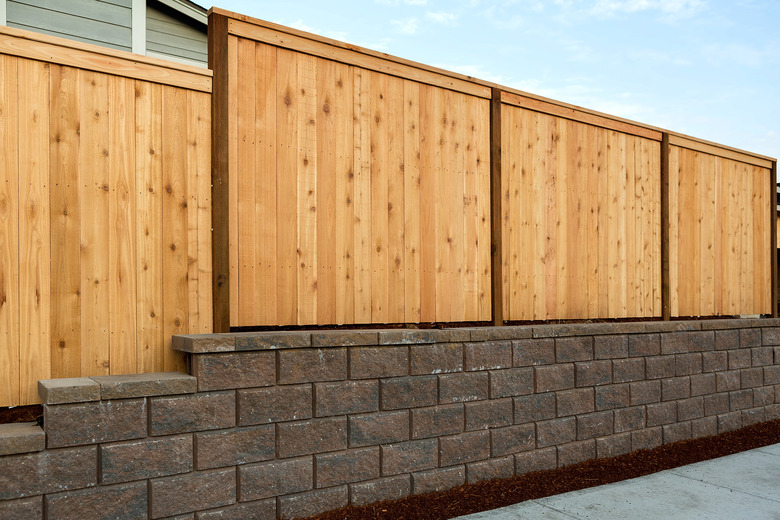How To Install 6 X 8 Wood Fence Panels
We may receive a commission on purchases made from links.
Installing fence panels made of wood is a great option for privacy fencing, and you can also find panels with pickets if you prefer an open design. You can find panels made from weather-resistant redwood or cedar, pine, cypress, or Douglas fir, which need a coat of paint or semitransparent stain to protect them from the elements unless they are pressure treated. The most common panel dimensions are 6 x 8 feet, which means the posts supporting the panels have to be 8 feet apart, and the height of the fence is 6 feet.
Panels are fencing options that greatly simplify fence installation, but there's one catch: Because they have fixed dimensions, the fence posts have to be spaced very accurately, and it's hard to get the correct spacing if you set all the posts in concrete before installing the panels. The way around this is to set the posts individually as you construct the fence.
How to Install 6 x 8 Wood Fence Panels
How to Install 6 x 8 Wood Fence Panels
Besides panels, you'll also need posts, and because one-third of each post needs to be buried to give the fence stability, you'll need to purchase 10-foot posts, which will be long enough to extend a little above a 6-foot fence. Posts should be pressure-treated to prevent rot.
1. Make Your Measurements
Construct each fence line separately. Start by marking the positions of the corner posts. Drive a stake on the location of each one and stretch a line between the stakes. Walk along the line with a tape measure and a can of marking paint and spray a mark on the ground at 8-foot intervals. Because you can't easily modify the widths of the panels, if one of the intervals is less than 8 feet, move one of the corner posts to compensate. If there's a gate on that line, you might also consider modifying the width of the gate opening.
2. Dig the Post Holes
Dig a hole wide and deep enough for a post on each of the marks. You can save yourself a lot of time by renting an auger rather than doing this job with a post-hole digger. Each hole needs to be 6 to 8 inches in diameter and 36 inches deep. Add about 3 inches to the depth and drop in that much gravel for drainage.
3. Set One Corner Post in Concrete
If the ground slopes, set the corner post on higher ground first. Drop one of the corner posts into its hole, level it with a 4-foot level, and either have a helper hold it steady or brace it with 2x4s while you backfill the hole with concrete to ground level or just below it. Wait overnight for the concrete to harden before continuing.
4. Set the Next Post, Brace It, and Make Measurements
Set the first line post in its hole and use a 2x4 spacer cut to the same length as the panel width to position the post at the correct distance from the corner post. Level the post and brace it securely with 2x4s. Make a mark on the corner post about 2 inches from the ground, tap a nail into the post on the mark, and stretch a line from the nail to the next post. Put a line level on the line, center the bubble, and make a mark on the post where the line intersects. If the ground slopes down from the corner, this mark may be farther from the ground than the one on the corner post.
5. Set the First Panel
Screw a short piece of 2x4 to each post with its top edge on the mark. These will support the panel temporarily while you fasten it to the post. Set the panel on the supports and make any needed adjustments to the supports to make the top of the panel level. Fasten the panel to the posts with 3-inch exterior screws or angle brackets if you prefer.
6. Finish the Fence Line and Backfill
Install all the rest of the panels the same way. When you install the last one, backfill all the post holes with concrete. Be sure to level each post before you backfill to prevent the fence from leaning backward or forward. Construct the other fence lines in the same way.
